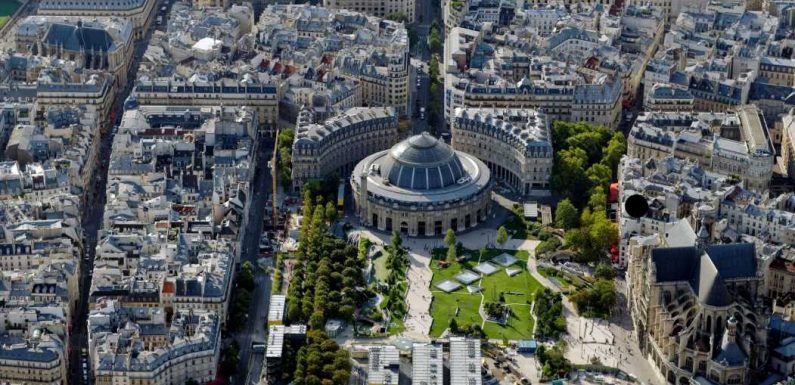
It all began at Karl Lagerfeld’s Left Bank apartment in 1997. The award-winning Japanese architect Tadao Ando was invited to dinner, and when he arrived, he met, there in the 18th-century entrance hall, the French financier François Pinault, a noted collector of contemporary art. “Was he aware that I would be there?” Ando muses now. “I am not sure. I sensed that Mr. Pinault might have asked Mr. Lagerfeld to introduce me to him, to understand what kind of person and architect I was.”
Pinault obviously was impressed: Over the last 20 years, he has enlisted Ando to design a suite of major art centers, including the Palazzo Grassi in Venice, and now the Bourse de Commerce–Pinault Collection, a private museum situated in the former commodities exchange in central Paris. A three-story circular edifice topped with an enormous glass cupola, the Bourse de Commerce has undergone many iterations since it was first constructed as the Hôtel de Soissons for Catherine de’ Medici in the 16th century. It took its most recent form, purpose, and name in 1889, the year of the world’s fair that also gave Paris the Eiffel Tower.
Ando has restored and transformed the building into a multi-use space, with seven galleries, a 284-seat auditorium, and a top-floor restaurant. The centerpiece of Ando’s refit is a 30-foot-tall cylinder of concrete—one of Ando’s preferred materials, which he manages to make appear light as chiffon. Its curves mirror the building’s existing structure and create a restful central gallery awash in natural light. “I love Tadao Ando’s minimalist aesthetic. His architecture is silent,” Pinault says. “No artifice, no unnecessary detail disturbs his architectural gesture, which succeeds in combining absolute simplicity and extreme complexity.”
Ando was born in Osaka in 1941, the first of male twins. As a teen in the mid-1950s, he visited the Imperial Hotel in Tokyo, an epic Mayan Revival structure designed by Frank Lloyd Wright. (It has since been torn down.) Wowed, Ando gave up his pursuit of professional boxing and turned to carpentry, then architecture. He skipped formal training, instead studying buildings by such modern masters as Wright, Le Corbusier, and Mies van der Rohe. Ando established his firm in 1969 and developed a style rooted in purity, beauty, and Japanese culture. For decades he worked almost exclusively in his homeland, attracting international attention for projects like his 1989 Church of the Light and 1984 Koshino House. By the early 2000s, however, he was busy designing buildings abroad, among them the Pulitzer Arts Foundation in St. Louis, Giorgio Armani’s headquarters in Milan, and the Modern Art Museum of Fort Worth.
In 2000, Ando won a competition mounted by Pinault to conceive a museum on the Île Seguin, a slim, crescent-shaped islet in the Seine, southwest of Paris, formerly the site of a Renault automobile factory. From the outset, there was a genuine complicity between two men. “We are both self-taught and share a common sensitivity to the impermanence and fragility of life,” explains Pinault, whose brief for the project was audacious. As Ando recalls, “He imagined the kind of architecture which ‘combines the qualities of a Gothic cathedral and a Romanesque chapel, with a dignified appearance and a tranquil, introspective space.’ I interpreted his words to mean an ‘eternal’ architecture—that is, a place with power that will remain in people’s hearts and minds forever.”
Five years later, after much French political red tape, Pinault abandoned the $195 million project. He asked Ando to instead revamp Palazzo Grassi, the 1772 palace overlooking the Grand Canal that Pinault had recently acquired to display his art. (Today, the collection totals more than 10,000 works by nearly 380 artists.) Pinault then tapped Ando for another Venice endeavor: the Punta della Dogana, a former customs building that Pinault leased from the city for 33 years to serve as a second exhibition space. Around the time of its completion, Ando discovered he had cancer. Following his successful treatment, he visited Paris and Pinault. Pleased to see his friend ready to work again, Pinault made a proposition: “I have a project in Paris in the planning stages. Can you design it?” That project was the Bourse de Commerce. “Without hesitation, I told him I would do it,” Ando says. “I thought that the responsibility of revitalizing architecture for society would color my life with vitality.”
Pinault was hands-on. “A true collaborator,” Ando says, “standing on the site from the early stages of construction to see the space come into reality, bit by bit.” For logistics meetings, they spoke through interpreters. But when on their own, they’d banter in their own languages, with a bit of English thrown in, and understood each other well. “Mr. Pinault’s overwhelming enthusiasm for building spaces for art, combined with his strong willpower always to persevere, never ceases to inspire me,” Ando says. “At the root of it all is his absolute love and trust for ‘art’ and his pure philanthropic spirit of sharing its culture with everyone. He is a rare leader who carries a great deal of responsibility in this day and age, yet still looks far into the future.”
Due to COVID-19 global lockdowns, Ando has not seen the Bourse de Commerce completed, with artworks installed. But he is sure that he will, and that it won’t be his final Pinault project. “Although I haven’t heard anything specific from him,” Ando says, “his eyes are filled with the same hope for the future since our first meeting. I was fortunate to have met a person like Mr. Pinault early on in my half-century career.”
Source: Read Full Article









